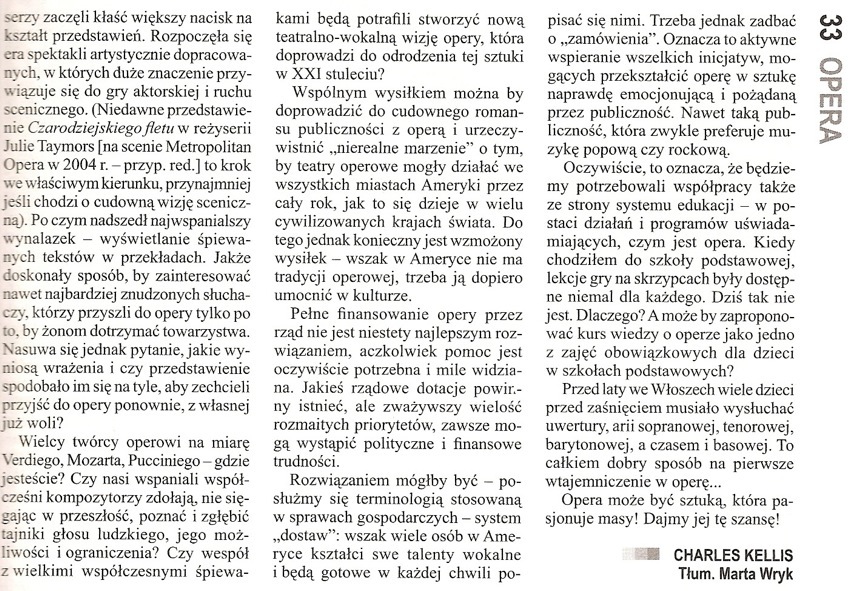CHARLES KELLIS

TWOJA MUZA (June - July) 2012/ English




Manon with Netrebko and Beczala
by Charles Kellis
An opera can be most appealing when it is well organized musically, with an orchestral input effectively supporting
the singers. It can be visually stimulating by the magic of imaginative set designs. It can be gracefully adorned, with a
core of ballet and a chorus that are well coordinated. Most importantly, however, it should provoke genuine excitement
through the quality of the artists who are the singing actors making it all fit together.
Monday night at the Met’s premiere of “Manon” this all became reality with a first rate cast of singers, set designs
that were mostly appropriately adaptable to the story, a chorus that sang with impeccable intonation. a ballet that was
strategically interpolated and musical nuances that were true to Massenett’s romantic intentions.
It was a sheer delight seeing Anna Netrebko play the part of Manon -- capturing the most charming coquettish kind
of adventurous impatience with a bouncing youthfulness, The choice of the two leading singers could not have been
better. The goal of making Opera more popular and readily appreciated by a wider audience was right on target.
Netrebko’s performance together with Piotr Beczala was vocally, as well as physically ---perfect type casting. They
blended beautifully in their duets and were particularly delightful in the first and second acts---imaginatively staged,
romantically conceived youthful intimacy.
Anna Netrebko is the undisputed famous diva of the opera world, but now here comes Piotr Beczala, a tenor who
has a wonderful voice, looks like a matinee idol and sings with a fluid musicality that, combined with an obvious charisma,
portends an impending great international career. He was outstanding in an easy, beautifully focused rendition of the “En
ferment les yeux” with an extraordinary high, pianissimo –“la naturale”-- reminiscent of Giusseppe DiStefano in his prime,
and showed true star quality, in an impassioned, musically nuanced, “Ah! fuyez douce image”.
Although the sets and their design were imaginative, there seemed to be a constant fear of a traffic jam taking place
in the director Laurent Pelly’s fourth act, when Gulliot, having been rejected by Manon, declared revenge and sent her
with her lover, Des Grieux to prison on the pretext of cheating in Cards. The zig zag nature of this puzzling, congested
labyrinth suggested a GPS with multiple turns and potential pitfalls. The amazing part, however, resulted in that the
geometric pattern became fully justified --as it all seemed to work out. Fortunately no one tripped or fell over. So the sets,
creative–albeit enigmatically designed by Chantal Thomas lived on in harmony with the perpetual movement.
The story, although it is adapted from the novel by Abbe Prevost, considered to be a famous book of many pages,
was forbidden reading in France in the early 1700’s. Like so many other librettos of that era, this libretto by the duo Henri
Meilac and Phillipe Gille develops some strain in trying to adapt a large expansive novel into a 3 hour opera. It does
manage, nonetheless, to bring out the colorful, enamored lightness of the first and second acts, the frivolity and
later pathos of the third act, the unfolding drama of the fourth, leading to the tragic gravitas of the fifth act conclusion.
The majestic sweeping romanticism and lusciously beautiful insights of Massenet were highlighted with a polished,
flowing graceful support of all the elements on stage by the conductor, Fabio Luisi, This included the ensembles,
ably handled by Anne Carolyn Byrd, Jennifer Black and Ginger Costa- Jackson and the excellent clarity of the words and
their collective unity by the continuing progress of the very efficient Met chorus.
The other singers were Paul Szlot whose voice rang with expression as Manon’s cousin, Lescaut; David Pittsinger,
Des Grieux’s father was stentorian and declamatory; Bradley Garvin as De Bretgny did a good job of misguiding the
fate of Manon; and Christophe Montagne was wonderfully limber, also producing a surprisingly good voice regardless of
the comedic character of Guillot.
The sold out expectation and excitement generated by the arrival of “Manon” proved to be one of the stellar
operatic performances of the season. The appearance of the superior tenor Beczala with his convincing dramatic input
and disciplined innate musicality, was testament to the rising standards and expectations of the met opera. Netrebko,
besides her usual impressive singing –is still in firm control of her world famous voice that seems to be growing even
fuller as she continues to mature (perhaps even a little fuller than the role of “Manon” requires). She showed her amazing
skills, carrying Manon from the ambivalence of the little teenager on her way to a convent, thru her betrayal of young
love with Des Grieux ---to a life of fantacy and adventure in Paris, returning again to Des Grieux with a stunning seduction
scene --relieving him of his priestly duties in a monastery-- to again living a life of frivolity in Paris. And then on to her
dying --in the arms of her lover, her true love the Chevalier Des Grieux. Despite a few moments of insecurity and
just --almost-- arriving at the high “re naturale” at the end of her famous aria, “ Gavotte”, her voice remains gorgeous and
she still reigns as “la diva assoluta”. Her wonderful portrayal of this wide-eyed little girl seeking adventure, falling into the
bowels of the vice and folly of Parisian society, allowed her the expanse and freedom to develop the character of Manon,
into a theatrical triumph.
FINE



